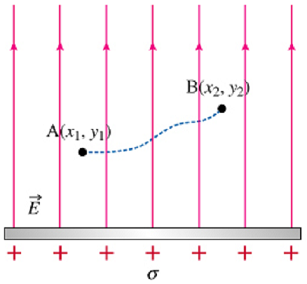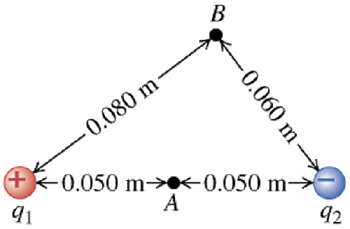Assignment Problem: Electric Potential Questions
Section 1: Potential Difference and Potential near a Charged Sheet
Question 1: Let A = (x1, y1) and B = (x2, y2) be two points near and on the same side of a charged sheet with surface charge density +σ. The electric field E→ due to such a charged sheet has magnitude E = σ/2∈0 everywhere, and the field points away from the sheet, as shown in the diagram.
Part A: What is the potential difference VAB = VA - VB between points A and B?

Question 2: At a certain distance from a point charge, the potential and electric field magnitude due to that charge are 4.98 V and 12.0 V/m, respectively. (Take the potential to be zero at infinity.)
Part A: What is the distance to the point charge?
Part B: What is the magnitude of the charge?
Part C: Is the electric field directed toward or away from the point charge?
Question 3: Two point charges q1 = 2.30 nC and q2 = -6.80 nC are 0.100 m apart. Point A is midway between them; point B is 0.080 m from q1 and 0.060 m from q2 (the figure). Take the electric potential to be zero at infinity.

Part A - Find the potential at point A.
Part B - Find the potential at point B.
Part C - Find the work done by the electric field on a charge of 2.50 nC that travels from point B to point A.
Question 4: Two large parallel conducting plates carrying opposite charges of equal magnitude are separated by 2.20 cm.
Part A - If the surface charge density for each plate has magnitude 47.0 nC/m2, what is the magnitude of E→ in the region between the plates?
Part B - What is the potential difference between the two plates?
Part C - If the separation between the plates is doubled while the surface charge density is kept constant at the value in part (a), what happens to the magnitude of the electric field?
- doubles
- stays the same
- halves
Part D: If the separation between the plates is doubled while the surface charge density is kept constant at the value in part (a), what happens to the potential difference?
- doubles
- stays the same
- halves
Question 5: A total electric charge of 3.50 nC is distributed uniformly over the surface of a metal sphere with a radius of 18.0 cm. The potential is zero at a point at infinity.
Part A - Find the value of the potential at 55.0 cm from the center of the sphere.
Part B - Find the value of the potential at 18.0 cm from the center of the sphere.
Part C - Find the value of the potential at 17.0 cm from the center of the sphere.
Section 2: Electric Potential, Potential Energy, and Force
Learning Goal: To review relationships among electric potential, electric potential energy, and force on a test charge.
Question 1: This question is a review of the relationship between an electric field E→, its associated electric potential V, the electric potential energy U, and the direction of force on a test charge.
Part A: Electric field lines always begin at _______ charges (or at infinity) and end at _______ charges (or at infinity). One could also say that the lines we use to represent an electric field indicate the direction in which a _______ test charge would initially move when released from rest. Which of the following fills in the three missing words correctly?
(positive; negative; negative)
(positive; negative; positive)
(negative; positive; negative)
(negative; positive; positive)
Our professional Electric Potential Assignment Help tutors are always dedicated and happy to assist you in all your academic dilemmas and provide you the most possible online assistance that no other can provide.
Tags: Electric Potential Assignment Help, Electric Potential Homework Help, Electric Potential Coursework, Electric Potential Solved Assignments